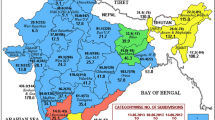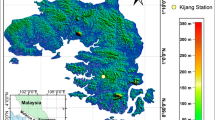Abstract
The purpose of this research is to study the structure and mechanism of heavy precipitation systems on the Arabian Peninsula and Iran and what is role of hot seas on providing moisture to these systems. To this end, precipitation data from 45 stations in the region during the period 1982–2017 were extracted. Based on local indices, the rainfall threshold of 30 mm was selected as the heavy rainfall criterion. By this criterion, 92 single-day systems with heavy rainfall were identified. By visual inspection of different atmospheric levels maps, one sample that comprised more than 80% of the samples were selected as the dominant model. The vertical structure and the moisture flux of this pattern were plotted in three boxes (system motion path). The results of this study showed that high humidity systems are supplied from three regions. In the first box (Sudan), the highest moisture advection in the lower troposphere comes from Intertropical Convergence Zone (ITCZ), the Indian Ocean, and the Arabian Sea; at second box comes from the Red Sea, Arab, and Oman; and the at third box comes from the Persian Gulf. The new finding of this research is the identification of a front line. This front line is caused by cold advection of polar side latitudes by a deep trough in the eastern Mediterranean and warm and humid advection of the southern warm seas, while so far it is thought that convection phenomenon to be the main cause of heavy rainfall and flooding in this region.











Similar content being viewed by others
References
Almazroui M, Awad AM (2016) Synoptic regimes associated with the eastern Mediterranean wet season cyclone tracks. Atmos Res 180:92–118
Alpert P, Neeman BU, Shay-El Y (1990) Intermonthly variability of cyclone tracks in the Mediterranean. J Clim 3(12):1474–1478
Alpert P, Osetinsky I, Ziv B, Shafir H (2004) A new seasons definition based on classified daily synoptic systems: an example for the eastern Mediterranean. Int J Climatol 24(8):1013–1021
Borzoi F, Azizi G (2015) Suggesting a simple criterion to estimate heavy rainfall in Iran. Phys Geogr Res Q 47(3):347–365
Dayan U, Ziv B, Margalit A, Morin E, Sharon D (2001) A severe autumn storm over the middle-east: synoptic and mesoscale convection analysis. Theor Appl Climatol 69(1–2):103–122
Draxler RR, Hess GD (1997) Description of the HYSPLIT_4 Modeling System. NOAA. Tech. Memo. ERL ARL-224, NOAA Air Resources Laboratory, Silver Spring, Maryland, pp 1–24
Draxler RR, Stunder B, Rolph G, Stein A, Taylor A (2014) HYSPLIT4 user’s guide, version 4.9, September 2009. Air Resources Laboratory, College Park
El-Fandy MG (1946) Barometric lows of Cyprus. Q J R Meteorol Soc 72(314):291–306
El-Fandy MG (1948) The effect of the Sudan monsoon low on the development of thundery conditions in Egpyt, Palestine and Syria. Q J R Meteorol Soc 74(319):31–38. https://doi.org/10.1002/qj.49707431904
El-Fandy MG (1950a) Troughs in the Upper Westerlies and cyclonic developments in the Nile Valley. Q J R Meteorol Soc 76(328):166–172
El-Fandy MG (1950b) Effects of topography and other factors on the movement of lows in the Middle East and Sudan. Bull Am Meteorol Soc 31(10):375–381
El-Fandy MG (1952) Forecasting thunder-storms in the Red Sea. Bull Am Meteorol Soc 33(8):332–338
Farajzadeh, M., Karimi Ahmadabad, M., Ghaemi, H., Mobasheri, M.R(2007) Studying the moisture flux over west of Iran: a case study of January 1 to 7, 1996 Rain Storm Journal of Applied Sciences. Vol. 7. PP. 3023–3030
Flohn H (1965a) Contributions to a synoptic climatology of North-East Africa. World Meteorological Organization, Tech Notes 69:236–244
Flohn H (1965b) Studies on the meteorology of tropical Africa, Part A: climatic anomalies in the Red sea. Bonner Met Abhandl 3:–35
Hafez Y (2012) Variability of Intertropical Convergence Zone (ITCZ) and extreme weather events. Atm Mod App:111–136. https://doi.org/10.5772/33809
Halabian AH, Hosseinalipour Jazi F (2016) Synoptic analysis of climatic hazards in southwestern Iran (case study: flood generating heavy precipitation of Azar 1391). J Spat Anal Environ Hazards 2(4):31–46. https://doi.org/10.18869/acadpub.jsaeh.2.4.31
Hejazizadeh Z, Zeaiean P, Karimi M, Rafati S (2015) Analysis of spatial and temporal patterns of convective systems with precipitation of more than 10mm. Geogr Dev Iran J 13(39):93–106. https://doi.org/10.22111/gdij.2015.2007
Johnson DH (1965) African synoptic meteorology. Meteorology and the desert Locus. World Meteorological Organization. Tech Notes (69):48–90
Kahana R, Ziv B, Dayan U, Enzel Y (2004) Atmospheric predictors for major floods in the Negev desert, Israel. Int J Climatol 24(9):1137–1147 https://rmets.onlinelibrary.wiley.com/doi/pdf/10.1002/joc.1056
Karimi, M(2007) The analysis of resources of precipitation moisture in Iran PhD. Thesis in natural geography. Supervisor Professor Manuchehr Farajzadeh. College of Human Sciences. Tabiat Modares University
Karimi M, Farajzadeh M (2011) Moisture flux and spatio-temporal patterns of resources of precipitation moisture of Iran. J Appl Res Geogr Sci 19(22):109–127
Karimi M, Khoshakhlagh F, Bazgir S, Jafari M (2017) The influence of lower tropospheric circulation of Arabian high pressure on iran. Precipitation Phys Geogr Res 48(4):587–569
Krichak SO, Alpert P, Krishnamurti TN (1997) Red Sea trough/cyclone development numerical investigation. Meteorog Atmos Phys 63(3–4):159–169. https://doi.org/10.1007/BF01027382
Lashkari H (2000) The development mechanism of the Red Sea Convergence Zone. Geogr Res Q 15(4–3):184–167
Lashkari H (2003) Synoptic patterns of heavy rainfalls in southwest of Iran (Doctoral dissertation, Ph. D. dissertation in Physical Geography. Tehran, Tarbiat Modarres University). Google Scholar
Lashkari H, Mohammadi Z (2015) The effect of the location of the Arabian subtropical high pressure on the precipitation systems in the south and southwest of Iran. Res Nat Geogr 47(1):73–90 http://www.sid.ir/En/Journal/ViewPaper.aspx?ID=461521Google Scholar
Lashkari H, Mohammadi Z (2018) Study on the role of annual movements of Arabian subtropical high pressure in the late start of precipitation in southern and southwestern Iran. Theor Appl Climatol 137(3-4):1–8. 2069-2076. https://doi.org/10.1007/s00704-018-2716-x
Lashkari H, Matkan A, Mohammadi Z (2016a) Local and time changes over a 66-year period and annual relocation of Saudi Arabian subtropical high pressure. Open J Geol 6:1080–1095. https://doi.org/10.4236/ojg.2016.69081
Lashkari H, Matkan A, Azadi M, Mohammadi Z (2016b) Synoptic analysis of Arabian subtropical high pressure and subtropical jet stream in shortest period of precipitation in south and south west of Iran. Environ Sci 14(4):59–74
Lashkari H, Matkan AA, Azadi M, Mohammadi Z (2017) Synoptic analysis of the role of Saudi Arabia subtropical high pressure subtropical and polar jet streams and severe droughts in south and south west of Iran. J Res Earth Sci 8(2):141–163
Mansourfar K (2009) Advanced statistical methods. Institute of Publishing and Printing, University of Tehran, Tehran
Meshkati AH, Moradi M (2004) Studying the trough of the Red Sea from a dynamic point of view. Nivar 52–53:53–74
Mofidi A (2006) Synoptic analysis of flood-making precipitations originated from the Red Sea. Geogr Res 4(75):71–93. https://profdoc.um.ac.ir/paper-abstract-1021576.html
Mohammadi Z, Lashkari H (2018) Effects of spatial movement of Arabia subtropical high pressure and subtropical jet on synoptic and thermodynamic patterns of intense wet years in the south and south West Iran. Phys Geogr Res Q 50(3):491–509
Pedgley DE (1966) The red sea convergence zone. Weather 21(11):394–406. https://doi.org/10.1002/j.1477-8696.1966.tb02788.x
Pedgley DE, Symmons PM (1968) Weather and the locust upsurge. Weather 23(12):484–492
Peixoto J P (1973) Atmospheric vapor flux computations for hydrological purposes. WMO contribution to the International Hydrological Decade (IHD)
Shadmani N, Esfahani N, Ali M, Ghasemi AR (2018) Determination of humidity sources and accurate trajectory of moist air mass effective on heavy rainfalls in west and south of Iran (case study: flooding events of October and November 2015). Iran J Geophys 12(2):50–63
Soliman KH (1953) Rainfall over Egypt. Q J R Meteorol Soc 79(341):389–397
Solot SB (1950) General circulation over the Anglo-Egyption Sudan and adjacent regions. Q J R Meteorol Soc 31:85–94
Trenberth KE, Fasullo JT, Mackaro J (2011) Atmospheric moisture transports from ocean to land and global energy flows in reanalyses. J Clim 24(18):4907–4924
Tsvieli Y, Zangvil A (2005) Synoptic climatological analysis of ‘wet’and ‘dry’Red Sea troughs over Israel. Int J Climatol 25(15):1997–2015
Tsvieli Y, Zangvil A (2007) Synoptic climatological analysis of Red Sea Trough and non-Red Sea Trough rain situations over Israel. Adv Geosci 12:137–143
Author information
Authors and Affiliations
Corresponding author
Additional information
Responsible Editor: Zhihua Zhang
Rights and permissions
About this article
Cite this article
Lashkari, H., Mohammadi, Z. & Jafari, M. Investigation on dynamical structure and moisture sources of heavy precipitation in south and south-west of Iran. Arab J Geosci 13, 1140 (2020). https://doi.org/10.1007/s12517-020-06097-w
Received:
Accepted:
Published:
DOI: https://doi.org/10.1007/s12517-020-06097-w




